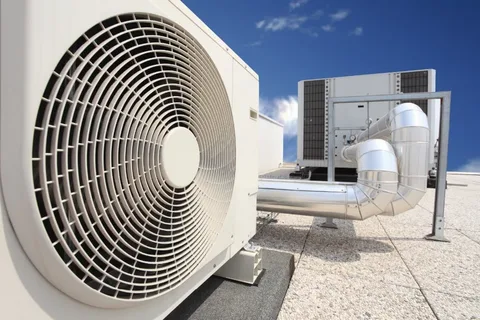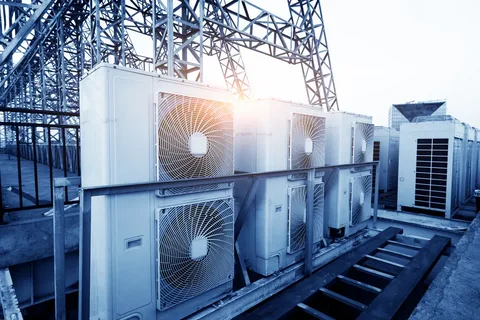A ventilation-fan may not be the first thing that comes to mind when you think about essential appliances in your home. However, this humble device is crucial in maintaining air quality and regulating temperature, making it a true unsung hero in your household. This blog post will delve into the importance of ventilation-fans, the different types available, key considerations when choosing one, installation tips, maintenance guidelines, troubleshooting common problems, and how to optimise your ventilation fan for energy efficiency.
Understanding the Role of Ventilation-Fans in Your Home
Ventilation-fans serve as the lungs of your home, subtly but significantly enhancing the living environment by circulating air and extracting pollutants, odours, and excess humidity. Their primary function is to safeguard the interior from the detrimental effects of stagnant air, which can harbour mould, mildew, and allergens. By fostering a continuous flow of fresh air, these devices help to mitigate health risks associated with poor air quality and ensure a more pleasant and habitable space.
In areas prone to high moisture levels, such as bathrooms and kitchens, ventilation-fans prevent dampness accumulation, thereby protecting structural integrity and preventing mould growth. Beyond health and structural benefits, these fans also contribute to thermal comfort, regulating temperature by removing overly warm or stale air. Their operation, while unobtrusive, is essential in maintaining an equilibrium between indoor air quality and environmental conditions, promoting a healthier and more comfortable home environment.
Types of Ventilation-Fans and Their Applications
The market offers a diverse range of ventilation-fans, each tailored for specific functions within the household. Extractor fans are particularly common in bathrooms and kitchens, where they excel at expelling moisture and odours, mitigating the risk of mould and dampness. For a more comprehensive solution, whole-house ventilation systems ensure consistent air circulation across all rooms, maintaining a uniform air quality and temperature. Loft fans prevent heat buildup within loft spaces, thus contributing to a cooler home environment during warmer months.
Cooker hoods installed above cookers are instrumental in removing cooking fumes and grease, ensuring the kitchen remains clean and pleasant. Window fans offer a straightforward approach to enhancing airflow, which is particularly beneficial in rooms that require quick and efficient ventilation. Each type serves a distinct purpose, reinforcing the importance of selecting the correct fan to meet the specific ventilation needs of different areas within your home.
Key Considerations When Choosing a Ventilation-Fan
When selecting a ventilation-fan, it’s imperative to weigh several critical factors to ensure you find the perfect match for your home’s needs. The dimensions of the space where the fan will operate play a pivotal role; a fan too small won’t effectively circulate air, whereas one too large could be overly powerful and unnecessarily noisy.
The level of ventilation required is another significant consideration, especially in areas with high moisture content like bathrooms and kitchens, where powerful extraction is necessary to combat dampness and odour. Noise is an often-overlooked factor, yet it’s crucial for maintaining a serene home environment. Look for fans with a low decibel rating to keep the ambient noise level minimal.
The fan’s efficiency is also paramount; opting for an energy-efficient model will reduce your carbon footprint and lead to considerable savings on your energy bills over time. Furthermore, modern ventilation-fans have additional features that could greatly enhance their convenience and functionality. Features such as humidity sensors, which trigger the fan to activate when moisture levels rise, or built-in timers to control operation periods can significantly add to the user experience.
Step-By-Step Guide to Installing a Ventilation-Fan
Installing a ventilation-fan may initially appear challenging, but it can be managed efficiently with appropriate preparation and tools. The optimal placement for your fan should be carefully selected, typically adjacent to the primary source of moisture or odours. Commence by marking and cutting a precise opening in the designated wall or ceiling to accommodate the fan housing. Proceed to securely fix the fan housing, ensuring it is firmly anchored.
Following this, establish a connection to the ductwork, facilitating effective air extraction outside your home. Electrical wiring is critical, requiring careful adherence to safety standards and regulations; if unsure, seek professional advice or assistance. Once the installation is complete, conduct a thorough test to verify the fan’s operational efficacy, adjusting settings as required for optimal performance. Regular engagement with these steps will ensure your ventilation-fan is installed successfully, contributing to enhanced air quality and comfort within your home.
Essential Maintenance Tips for Your Ventilation Fan
Consistent upkeep is crucial to safeguarding the efficiency and longevity of your ventilation fan. Initiating with the fan blades, it’s vital to dislodge any accumulation of dust and debris that can impede airflow and diminish the fan’s efficacy. A soft brush or a vacuum with an attachment can be effective. Further, inspect the housing and ductwork for any build-up that could obstruct air passage.
Over time, components may become loose or suffer wear and tear; these should be promptly addressed. For instance, securing loose parts can prevent unnecessary noise and vibration, whilst replacing damaged components ensures the fan continues functioning as intended. Moving parts benefit from occasional lubrication, which can stave off issues related to friction and wear. Another critical aspect involves monitoring the fan motor.
Signs of overheating, such as unusual sounds or smells, warrant immediate attention to preclude more severe malfunctions. If these maintenance tasks seem daunting or anomalies persist, engaging a professional’s services is advisable to guarantee the fan remains in prime working order. Regular attention to these details can significantly enhance your ventilation-fan’s performance, contributing to improved air quality in your home.
Troubleshooting Common Ventilation-Fan Problems
Navigating through the labyrinth of issues that may arise with ventilation-fans requires a keen understanding of their common malfunctions. One pervasive problem many encounter is the fan generating an unusual amount of noise, often a symptom of obstruction in the blades or an imbalance. A meticulous inspection and cleaning of the fan blades can rectify this issue, restoring tranquillity to your environment.
Diminished airflow, another frequent concern, could signal a blockage within the ductwork or an issue with the fan’s motor. Ensuring the ducts are clear of debris and verifying the motor’s functionality are pivotal steps towards resolution. Electrical complications can also impede the performance of your ventilation-fan. These may manifest through intermittent operation or complete failure to turn on.
Checking the connections and ensuring the fan is correctly wired can illuminate the path to a solution. Should these troubleshooting endeavours not yield success, or if the problem seems rooted in the fan’s internal components, seeking the expertise of a professional may be the wisest course of action. Their specialised knowledge can identify less obvious faults, ensuring your ventilation-fan remains vital in maintaining a healthy home environment.
Optimising Your Ventilation-Fan for Energy Efficiency
Optimising the energy efficiency of your ventilation-fan not only supports a sustainable environment but also curtails your energy expenses. By implementing a few strategic practices, you can significantly enhance the performance of your ventilation system whilst keeping energy consumption in check.
Upgrade to Energy-Efficient Models
Modern ventilation-fans are designed with energy conservation in mind. Investing in a model with an Energy Star rating can lead to substantial savings on your electricity bill, as they use less power than traditional fans.
Utilise Timers and Sensors
Installing timers or humidity sensors can drastically improve the efficiency of your ventilation-fan. These devices enable the fan to operate only when necessary, such as during high humidity levels, thereby avoiding constant running that increases energy use.
Regular Maintenance and Cleaning
Keeping your ventilation-fan clean from dust and debris ensures it operates efficiently. A clogged fan has to work harder and use more energy to circulate air. Regular maintenance checks also identify potential issues impairing energy efficiency, such as worn-out components.
Correct Sizing and Installation
Ensuring your ventilation-fan is the appropriate size for the space it serves is crucial for energy efficiency. A fan that’s too small will run continuously without effectively improving air quality, whilst a fan that’s too large for the space can waste energy. Proper installation by a professional ensures that the fan operates efficiently and is correctly sealed and vented to the outside.
Energy Efficiency – Maximising Savings on Your Ventilation-Fan
Achieving energy efficiency with your ventilation-fan aligns with eco-friendly practices and promises tangible reductions in your energy expenditure. Central to realising these savings is the strategic use of your fan. Tailoring fan use to specific needs—like addressing high moisture levels immediately—avoids unnecessary operation. Innovatively, incorporating smart technology allows for meticulous control over your fan’s activity. Programmable devices can adjust the fan’s operation based on real-time requirements, preventing it from running when unnecessary.
Enhancing your home’s insulation is an overlooked yet effective strategy; this step crucially reduces the demand for your ventilation system by maintaining a more consistent indoor climate. Leveraging natural ventilation techniques, such as opening windows during cooler periods, can significantly reduce the need for mechanical assistance, further conserving energy. By adopting these approaches, you can minimise your carbon footprint and witness a notable decrease in energy bills, fostering both an environmentally and financially sustainable living environment.
Conclusion
Navigating the intricacies of selecting, installing, and maintaining a ventilation-fan reveals its pivotal role in ensuring a healthy, comfortable, and energy-efficient home environment. Emphasising its status as the unsung hero of domestic spaces, this exploration illuminates ventilation-fans’ subtle yet significant impact. Adhering to the guidance provided, homeowners can enhance their living spaces, championing sustainability and well-being. Engaging with this knowledge empowers individuals to make informed decisions, elevating the quality of their indoor environment through strategic ventilation management.
 FAQs
FAQs
1. What is a ventilation-fan, and how does it work?
A ventilation-fan is a mechanical device designed to circulate air within a space. It works by drawing stale air out and bringing fresh air in, thus maintaining indoor air quality. The fan blades, powered by an electric motor, create airflow that helps to ventilate areas such as kitchens, bathrooms, and industrial spaces.
2. Why is a ventilation-fan important for indoor air quality?
A ventilation-fan is crucial for maintaining good indoor air quality by removing pollutants, odours, and excess moisture. Without adequate ventilation, contaminants like dust, mould spores, and harmful gases can accumulate, potentially causing health issues and damage to the building structure.
3. How do you choose the right size for a ventilation fan?
Selecting the right size for a ventilation fan depends on the room’s dimensions and specific ventilation needs. Calculate the room’s volume (length x width x height) and choose a fan with a suitable cubic feet per minute (CFM) rating. Bathrooms typically require a fan with 50-110 CFM, while larger spaces may need higher ratings.
4. Can a ventilation-fan reduce humidity in a bathroom?
Yes, a ventilation-fan is effective in reducing bathroom humidity. Expelling moist air outside prevents condensation on walls and mirrors, reduces the risk of mould growth, and maintains a comfortable environment. Running the fan during and after showers is recommended for optimal results.
5. How often should a ventilation-fan be cleaned or maintained?
A ventilation-fan should be cleaned every six months to ensure optimal performance. Dust and debris can accumulate on the fan blades and motor, reducing efficiency. Regular maintenance includes removing the cover, cleaning the blades with a damp cloth, and checking for any blockages in the vent.
| Other Good Articles to Read |
| Niche Blogs Connect |
| Blogs 97 |
| Blog Stitution |
| Blogs Unplugged |
| Blogs Cotch Rouge |
| Blog Signatr |
| Blog Sintonias |
| Blog Zilla |
| Consumer Forums |
| Finance Forums |
| G Blogs |
| Too Blog |
| Related Business Listings |
| Contact Directory |
| Local Business Profiles |
